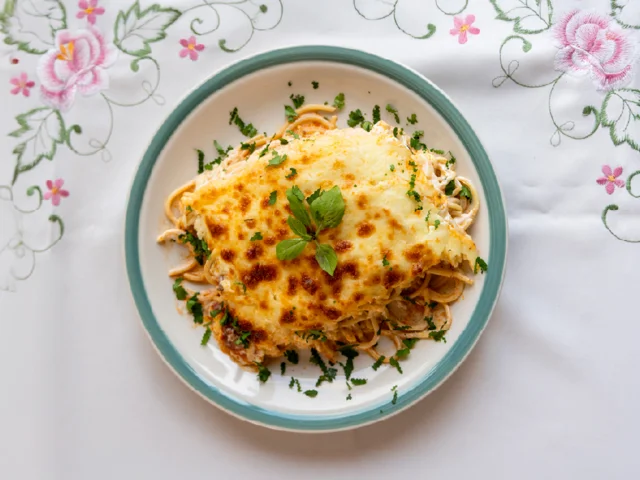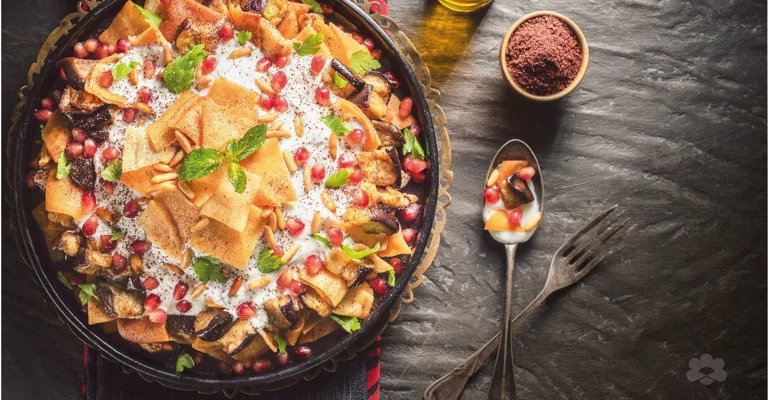


If you want to, you can prepare eggplant fatteh ahead of time. While you could cook the entire dish and reheat it when you are ready to enjoy it, we recommend instead to prep the components beforehand and store them in the fridge and roast the eggplant fatteh fresh. This keeps the bread base crispy and the textual integrity of the eggplant fatteh intact. Store the meat filling and eggplant skins separately in refrigerated airtight containers and fried bread on the countertop.
Fatteh is a dish made with fried, toasted, or grilled bread. Popular across Northern Africa and the Middle East, it usually has plenty of fresh and crunchy toppings, a creamy dressing, and, of course, a sauce with meat and/or various vegetables. Eggplant fatteh then is, as the name would suggest, a hearty version featuring eggplant. The popular dish fattoush, which is a bread salad often made with pieces of pita bread, is also part of the fatteh family of bread dishes. This dish, too, can be made as a roasted eggplant fattoush.
Though it contains many different components, tastes, and textures, a traditional fatteh with eggplant and meat is not difficult to make. To start, prepare the eggplants by removing the flesh while keeping the skins intact. Cook the spiced meat and diced eggplant filling with pine nuts. Fill the skins with this meat filling, place them in a deep pan, and pour in the easy tomato sauce. As they cook, prepare the dressing, and fry the bread. Served on a decorative platter layered with fried bread, stuffed eggplants in tomato sauce, yoghurt, and crispy toppings, this roasted eggplant fatteh is sure to delight.
Eggplant fatteh is traditionally served with a yoghurt dressing. This dressing is most often flavoured with tahini paste. Tahini, which is made from roasted sesame seeds, has an intense earthy flavour with nutty and salty qualities. The dressing may also be seasoned with salt and pepper, lemon juice for additional brightness, or crushed garlic for a flavourful and pungent inclusion.
As no eggplant fatteh is authentic without fried bread, you will need a few tips for how to make fatteh bread crispy. Cut Arabic flatbread into squares as you heat some vegetable oil in a pan. Toss the bread pieces into the warm pan and fry them for a few minutes or until they are golden and crispy. If you want to, the warm, fried bread can be seasoned with your spices of choice.
Flavoured with aromatic, warming allspice, sweet-spicy cinnamon, as well as nutty and slightly sweet pine nuts, this eggplant fatteh with meat has a lot of depth and flavour. Made with lamb, the earthy qualities of the spices are more pronounced as the taste of this gamey meat enhances them. With beef, the umami flavour of the meat itself is more prominent. Regardless of which juicy, tender minced meat you choose to use, this classic dish with fried bread is filled with flavour as well as different textures to make it interesting.
Decorative, jewel-like pomegranate seeds, fried onions, and toasted pine nuts adorn the tahini yoghurt atop this eggplant fatteh and make for crispy, crunchy toppings. The pairing of sweet-tart fruitiness, umami, and nutty goodness makes for a delectable combination that complements the spiced eggplant, meat, and savoury, yet sweet-tangy, tomato sauce.
To complement the crunchy toppings, an eggplant fatteh must be topped with a velvety yoghurt-based dressing. Flavouring it with a Middle Eastern classic like tahini is incredibly tasty. The intense sesame paste's nutty, salty flavour pairs well with the round, mild-tasting neutral yoghurt.
Together, these lovely ingredients create a creamy, flavourful eggplant fatteh yoghurt to slather on top of the dish. The nutty flavours of this dressing also serve to highlight the taste of the toasted pine nuts used both in and on top of it.
The best eggplant fatteh recipe is, of course, not complete without the crispy bread. Arabic flatbread is an ideal choice for this obligatory fatteh bread base. Though some recipes will suggest toasting or grilling the bread, we believe the best, crispiest result is by frying it.
Flatbread lends itself well to serve as a base and garnish for an eggplant fatteh as layering the dish with this type of bread is easier than with more voluminous kinds. Flatbread also becomes incredibly delicious and crispy when pan-fried.
A tasty way to experiment with this traditional eggplant fatteh is to add warm chickpeas. Soaking dry chickpeas and boiling them yourself allows you to flavour them any way you like. Try boiling them in spice-infused water with bay leaves, ground cumin, sliced garlic cloves, and a bit of sumac for spiced chickpeas with earthy and citrussy notes as well as plenty of depth.
If you enjoy crunchy textures and want to introduce even more into this lamb or beef and eggplant fatteh, you can fry the boiled chickpeas in a bit of olive oil to make them slightly crispy.
For additional freshness, you can use fresh parsley as a garnish. This mildly bitter and peppery herb, together with the pomegranate seeds, serves to brighten the dish. In addition, the play of colours created by the mix of ruby-red seeds, bright green herbs, and white tahini yoghurt, makes for a stunning display that is sure to impress your family and iftar guests.

Fall in love with pasta all over again, as you serve your loved ones creamy dishes made richer with Puck—and your special touch. Our inspiring recipes, general guidelines, and detailed articles will set you on the path to culinary creativity. With Puck’s entire range of cooking creams and sauces that meet your high standards, you’ll love putting your personal spin on pasta.